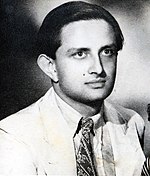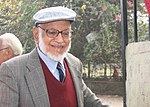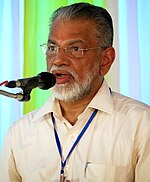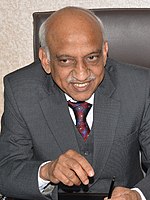ਭਾਰਤੀ ਪੁਲਾੜ ਖੋਜ ਸੰਸਥਾ ਦੇ ਚੇਅਰਮੈਨ
| ਇਸ ਹਿੱਸੇ/ਲੇਖ ਨੂੰ ਪੰਜਾਬੀ ਵਿੱਚ ਅਨੁਵਾਦ ਕਰਨ ਦੀ ਜਰੂਰਤ ਹੈ ਹੈ। ਤੁਸੀਂ ਇਸਦਾ ਪੰਜਾਬੀ ਵਿੱਚ ਅਨੁਵਾਦ ਕਰਕੇ ਵਿਕੀਪੀਡੀਆ ਦੀ ਮਦਦ ਕਰ ਸਕਦੇ ਹੋ। |
| No. | Portrait | Name (Lifespan) |
Term | Ref(s) | ||
|---|---|---|---|---|---|---|
| Start | End | Term length | ||||
| 1 | 
|
Vikram Sarabhai (1919–1971) |
1963 | 1971 | 8 years | [1] |
| Founder of INCOSPAR and widely regraded as father of Indian space program. His efforts led to creation of Indian Space Research Organisation. | ||||||
| 2 | 
|
M. G. K. Menon (1928–2016) |
January 1972 | September 1972 | 9 months | [2] |
| He was notable mostly for his work on cosmic rays and particle physics particularly on the high-energy inter-actions of elementary particles. | ||||||
| 3 | Sathish Dhawan (1920–2002) |
1972 | 1984 | 12 years | [3] | |
| Satish Dhawan is known for his work on fluid dynamics and his tenure as longest serving chief of ISRO. His era marked with India attaining orbital launch capability in 1980 for the first time and start of INSAT program which became base for further development of spacecraft technologies. | ||||||
| 4 | 
|
U. R. Rao (1932–2017) |
1984 | 1994 | 10 years | [4][5] |
| Also served as chancellor of Indian Institute of Space Science and Technology; Rao pushed for launch vehicle development which subsequently lead to realisation of PSLV and later GSLV rockets, marked as key boosts to India's space capabilities. Launch capabilities with INSAT program eventually turned India into a major spacefaring nation. | ||||||
| 5 | 
|
K. Kasturirangan (1940– ) |
1994 | 27 August 2003 | 9 years | [6] |
| His era marked development of improved spacecraft in INSAT series and development of IRS series of remote sensing satellites and major improvements in earth observation satellite technologies. His tenure also saw operationalisation of PSLVs and first flight of GSLV which made India self sufficient launching its smaller & medium EO satellites. | ||||||
| 6 | 
|
G. Madhavan Nair (1943– ) |
September 2003 | 29 October 2009 | 6 years | [7] |
| Nair holds significant expertise on development of multi-stage launch vehicles and his era witnessed operationalisation of various variants of PSLV rocket. His tenure saw commencement of Indian Human Spaceflight Programme and launch of extraterrestrial exploration mission Chandrayaan-I. Following a controversial S-band spectrum deal involving Antrix Corporation, he had to step down. | ||||||
| 7 | 
|
K. Radhakrishnan (1949– ) |
30 October 2009 | 31 December 2014 | 5 years, 62 days | [8][9][10] |
| He joined VSSC as a development engineer for electro-mechanical devices of launch vehicles and later oversaw annual budget and plans and database for resources. Introduction of IRNSS made India one of few countries with own navigation systems while introduction of GSLV Mk III later enabled India to launch its heavier satellites also. His era also witnessed successful launch and orbital insertion of Mangalyaan, India's first mars mission and cancellation of collaboration with Russia and redefining Chandrayaan-2 with Indian design and systems. Successful flight of India's own cryogenic stage on GSLV-D5 made it one of six countries with full launch capabilities.[lower-alpha 1] | ||||||
| - | 
|
Shailesh Nayak (1953– ) |
1 January 2015 | 12 January 2015 | 11 days | [11] |
| He was primarily engaged studies related to oceanography and remote sensing and served as interim chief of ISRO for a brief period of 11 days. | ||||||
| 8 | 
|
A. S. Kiran Kumar (1952– ) |
14 January 2015 | 14 January 2018 | 3 years, 0 days | [12] |
| His tenure is attributed with HEX which marks with beginning of development of reusable-launch vehicle, first orbital flight of GSLV Mk III, completion of NAVIC and launch of Astrosat, India's first space based observatory. | ||||||
| 9 | 
|
K. Sivan (1957– ) |
15 January 2018 | 15 January 2022 | 4 years, 0 days | [13] |
| He earlier served as director of VSSC and LPSC and participated in development of PSLV rockets. His tenure was marked by the Chandrayaan-2 project which resulted in a failed moon landing. His tenure also saw the acceleration of India's manned space program. Short term goals include launch of Chandrayaan-3 to attempt a successful soft lunar landing, putting humans in space, launching missions to Venus and sun and development of SCE-200 rocket engine to facilitate realisation of India's heavy lift launch vehicle and increase commercial operations. He is also known for developing trajectory simulation software named SITARA which is still in use by ISRO. | ||||||
| 10 | 
|
S. Somanath (1963– ) |
15 January 2022 | Incumbent | 245 days | [14] |
| Somanath is known for his contributions to launch vehicle design, particularly in the areas of launch vehicle systems engineering, structural design, structural dynamics, and pyrotechnics.[15][16] He also served as the Director of Vikram Sarabhai Space Centre, Thiruvananthapuram and [17]Director of Liquid Propulsion Systems Centre, Thiruvananthapuram.[18] He was associated with the PSLV project and was the project director of GSLV Mk III in 2010.<ref name="isro-215" </ref> | ||||||
ਹਵਾਲੇ[ਸੋਧੋ]
- ↑ "Welcome To ISRO :: Former Chairman :: Dr. Vikram Sarabhai - Introduction". isro.org. Archived from the original on 2013-11-14. Retrieved 2014-02-14.
- ↑ "Welcome To ISRO :: Former Cha". isro.org. Archived from the original on 2014-02-11. Retrieved 2014-02-14.
- ↑ "Welcome To ISRO :: Former Chairmen :: Prof Satish Dhawan". isro.org. Archived from the original on 2014-02-11. Retrieved 2014-02-14.
- ↑ "Welcome To ISRO :: Former Chairman - Prof.Udupi Ramachandra Rao". isro.org. Archived from the original on 2014-02-11. Retrieved 2014-02-14.
- ↑ "Welcome to ISRO :: Former Chairman :: Prof. Udupi Ramachandra Rao - Introduction". Archived from the original on 7 January 2014. Retrieved 2020-09-28.
- ↑ "Welcome To ISRO :: Former Chairman :: Dr. Krishnaswamy Kasturirangan - Introduction". isro.org. Archived from the original on 2014-10-26. Retrieved 2014-02-14.
- ↑ "Shri G Madhavan Nair". About ISRO. Indian Space Research Organisation. 2008-11-11. Archived from the original on 2009-11-11. Retrieved 2009-11-01.
- ↑ "Dr. K. Radhakrishnan". About ISRO. Indian Space Research Organisation. 2008-11-11. Archived from the original on 2013-11-12. Retrieved 2009-11-01.
- ↑ "India's space odyssey: ISRO creates history in 2014". The Indian Express. 2014-12-27. Retrieved 2020-09-28.
- ↑ "ISRO's Timeline from 1960s to Today - ISRO". Indian Space Research Organisation. Archived from the original on 2020-09-27. Retrieved 2020-09-28.
{{cite web}}: Unknown parameter|dead-url=ignored (|url-status=suggested) (help) - ↑ Shailesh Nayak appointed as new ISRO chairman, Radhakrishnan retires
- ↑ "A S Kiran Kumar takes over as Secretary, Department of Space, Chairman, Space Commission and Chairman, ISRO". www.isro.gov.in. Archived from the original on 2016-10-16. Retrieved 2016-10-17.
{{cite web}}: Unknown parameter|dead-url=ignored (|url-status=suggested) (help) - ↑ "K. Sivan takes charge as new ISRO chairman". The Hindu (in Indian English). 16 January 2018. Retrieved 1 November 2018.
- ↑ "Malayali scientist Dr S Somanath appointed as ISRO chairman". Kerala Kaumudi (in Indian English). Thiruvanathapuram. 2022-01-12. Retrieved 2022-01-13.
- ↑ "New Directors for Three Major ISRO Centres: Three major ISRO Centres have new Directors from today". www.isro.gov.in. 1 June 2015. Archived from the original on 2018-01-23. Retrieved 2022-01-13.
{{cite web}}: Unknown parameter|dead-url=ignored (|url-status=suggested) (help) - ↑ Prasanna, Laxmi (January 22, 2018). "S Somnath takes charge as Vikram Sarabhai Space Centre's director". The Times of India (in ਅੰਗਰੇਜ਼ੀ). Retrieved 2022-01-13.
- ↑ "Somanath takes charge as VSSC director". www.indiatoday.in. 22 January 2018. Retrieved 2022-01-13.
- ↑ India, Press Trust of (22 January 2018). "Somanath takes charge as VSSC director". Business Standard India. Retrieved 2022-01-13.
ਹਵਾਲੇ ਵਿੱਚ ਗਲਤੀ:<ref> tags exist for a group named "lower-alpha", but no corresponding <references group="lower-alpha"/> tag was found
